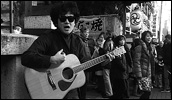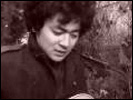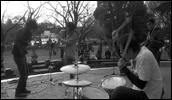Live Tape
- Year
- 2010
- Original title
- Raibu Tepu
- Japanese title
- ライブテープ
- Director
- Cast
- Running time
- 74 minutes
- Published
- 1 May 2010



by Jasper Sharp
If one wanted to pinpoint the most significant development in cinema's ongoing evolution over the past decade, it would have to be the quiet revolution brought about by advances in digital filmmaking technology. It is easy to forget that when Lars von Trier and Thomas Vinterberg launched the Dogme 95 manifesto, with Festen and The Idiots (Idioterne) both released in 1998, it was intended as an affront to the then atrophied state of commercial cinema exemplified by the output of Hollywood, a reminder that glossy production values were not the be-all and end-all if you had a good story, an interesting message, and a strong visual sense. Still, even when I first saw Ryuichi Hiroki's Tokyo Trash Baby back in 2000, the dominant feeling was still that films shot on video were not "proper" films.
Now one almost takes for granted the large number of documentaries and indie works that would not have been possible without the increased portability of lightweight video cameras, the ability to shoot without artificial lighting, the affordability of tape versus film stock, and the flexibility in editing and post-production. Developments in production and exhibition via DVD have given rise to new filmmaking cultures where virtually nothing existed before; the Nigerian Nollywood phenomenon providing perhaps the best example, but there's also notable individual works such as the remarkable Inuit film Atanarjuat: The Fast Runner (2001). We've done our utmost to keep abreast with developments in Japan's flourishing jishu eiga field here at Midnight Eye, but with numerous big-budget productions all over the world increasingly turning away from celluloid, nowadays one barely mentions, indeed one is barely aware, whether a film is shot on 35mm or digitally. Whether one likes it or not, it is pretty clear that over the next few years digital projection will also become the norm.
Digital video's role in allowing a whole new generation of newcomers, as well as established filmmakers, to bring their ideas to the screen more cheaply and expediently barely needs emphasising, but still, one might argue that the majority of such works rarely explore the aesthetic possibilities unique to the medium. Most are stories that could just as easily have been told on film in exactly the same manner, albeit on a higher budget. The most obvious exceptions of works that have explored the new forms made possible by video, exploiting the portability and longer shooting times permitted by the camera, actually came early on in the decade. Mike Figgis's underrated Timecode (2000), a playful and irreverent look at the behind-the-scenes shenanigans at a Hollywood production company, followed its characters through four separate screens in lengthy unbroken takes (although actually not quite - the film introduced the deus ex machina of sporadic earth tremors to re-synch the action at times). On a technical level, Alexander Sokurov was perhaps even more revolutionary in his realisation of Russian Ark (2002) within the format of a single 96-minute POV shot, as the film's narrator wanders through Saint Peterburg's Winter Palace seething with crowds of costumed extras.
Sokurov's heritage piece clearly must have been a logistical nightmare to shoot, but though a milestone work in world cinema, to my mind it lacked much in the way of a dramatic hook and, dare I say it, might even be regarded a little pretentious. Still, the film provides the closest reference point for Live Tape, Tetsuaki Matsue's low-fi, single-shot music documentary filmed on New Year's Day in 2009. Its 74 minutes just fitting into a single video tape, Matsue's film features the tousle-headed folk singer Kenta Maeno as he walks from Hachiman shrine through the streets of Tokyo's coolest suburb, Kichijoji, performing with his guitar and occasionally meeting with other musicians at key points on his route before they all unite for an exuberant finale in Inokashira Park.
The above synopsis in itself presents some difficulties. Can Live Tape accurately be described as a music documentary or concert film? For much of it, Maeno's performance takes place without any real sense of audience, so to speak - just Matsue, his cameraman Ryuto Kondo (who lensed, among other works, Satoko Yokohama's Bare Essence of Life and Kazuyoshi Kumakiri's Non-Ko), and the numerous peripheral bystanders who remain silent witnesses to this happening, surreptitiously casting the occasional curious glance in that uniquely Japanese way, but generally ignoring the fact that something out of the ordinary might be happening. If this were a single shot of Maeno performing live on a stage, then the film would stand or fall entirely on the music, but the fact that both Maeno and camera are mobile throughout their environment definitely adds a little something. If nothing else, like Sokurov's film, Live Tape succeeds as a poignant invocation of time and place, except that it charts a contemporary milieu rather than a reconstructed historical one, and as such may well come to be seen as a vital time-capsule document in years to come in the same way we might nowadays regard films such as Nagisa Oshima's Diary of a Shinjuku Thief or Toshio Matsumoto's Funeral Parade of Roses. For those who know the area, there's certainly a lot of fun to be had spotting familiar landmarks. Those who have never been to Japan might find it just as enjoyable being immersed in this separate lived-in reality by proxy.
Part of one's appreciation hinges on how one warms to Maeno's pared-down brand of acoustic folk, which might hardly break new ground musically but benefits from the flippant and occasionally surreal poetry of his lyrics. In the opening number he reminisces about "That Summer at 18 I whacked off to Lost Paradise", a pop-cultural reference that might be lost on audiences unfamiliar with Yoshimitsu Morita's 1997 box-office barnstormer, whose nostalgic, sentimental tale of impossible love featured some surprisingly steamy sex scenes for a film of such a nature. Elsewhere he croons about wanting to live with his girlfriend "in a big phallic apartment, with only some of the lights on" and laments how his daily life is as bland as tofu.
For the first half of the film, it might all seem rather one-note, however, and certainly there were a few walk-outs during the otherwise packed screening at Nippon Connection. But this is not a film that requires the customary levels of audience participation one expects from narrative fiction, where one is invited to participate in the game of guessing every turn in events and the overall agenda of the director. It is a film to sit back and enjoy on a purely emotional level, and if you roll with it, you can't help but be won over by Maeno's insouciant charm.
But there's a lot more to proceedings than just the music. There's also the question of who is leading the dance here, Maeno or Matsue? Those who have followed Matsue's filmmaking career will be aware of the director's tendency to put himself centre stage. This was understandable enough in his debut film Annyong Kimchee in 1999, a video essay on his own cultural identity as a third-generation Korean resident in Japan, but in subsequent works, such as his 2004 examination of zainichi performers in the AV industry, Identity, and The Virgin Wildsides (Dotei o Purodyusu, 2007) diptych, part of which revolved around his efforts to get his "cherry boy" friend laid during a porno shoot, his on-camera and off-camera presence bordered on the megalomaniacal.
Matsue's unabashed involvement in the AV industry certainly has had a large bearing on his jishu eiga documentaries, as he himself has emphasized. If hardcore pornography can be considered akin to documentary in its frank recording of an un-constructed "reality", then it must also be acknowledged that this reality is staged entirely for a posited viewer, a point constantly acknowledged in Matsue's films in his foregrounding of his own role as a director, the engineer of this reality. As such, issues of power relations become a salient point of Matsue's method, but one sometimes gets the impression that he is either unaware or indifferent to the responsibility that this gives him. It is for this reason that I've had reservations about his work in the past.
Both the strengths and limitations of his abilities as a documentary maker are perhaps most clearly manifested in his other film from last year that also screened at Nippon Connection 2010, Annyong Yumika, a portrait of the pink/AV idol Yumika Hayashi (best known outside of Japan for her role in Shinji Imaoka's 2003 pink film Lunchbox), who was tragically found dead in her apartment in 2005. On the plus side, for a foreign viewer in particular the film provides a thoroughly entertaining and enlightening peak behind the scenes of Japan's crazy sex film industry. Matsue's obsessive quest to get to the roots of a bizarre Korean softcore production shot in Tokyo that came to light after its starlet's death is a clear demonstration of his strong ability to make something entertaining out of very little, just as he had done in the past with earlier films like Every Japanese Woman Makes Her Own Curry (2003). If Matsue's film is about chasing illusions, then this would be fine; we never really gain any real insight into his subject, but the journey is a fun one. But his interviews with those close to Yumika occasionally feel that little too intrusive and prurient (at one point he is warned by her former lover that he is heading into some very sensitive territory), and his voiceover coda that hints at an affair with one of her Korean co-stars, as well as having a large "so what?" factor about it, attributes motivations and actions to a person who is no longer alive to tell her part of the story.
That said, Matsue's films always seem to inspire a vigorous debate among those who have followed his career, and there's usually a hell of a lot more going on than initially meets the eye. The fact that he makes such rich works for dissection on such minimal means certainly ensure him his place at the forefront of the contemporary jishu eiga scene.
The suspicion that Matsue's documentaries have less to do with their ostensible subject matter than his own role in shaping the material is hardly dispelled by Live Tape, but in this case the events unfolding onscreen benefit from this palpable tension between him and his subject. At the beginning, Maeno's too-cool-for-school persona might lead us into thinking we're in for a long ride as, eyes hidden behind a pair of Raybans, he roams through the streets channelling Dylan while remaining frustratingly indifferent to the camera. What is fun is watching how he reacts to Matsue's off-camera badgering to act less cool, remove his sunglasses, or crank up his guitar a notch, or the attempts to coax him back onto their pre-planned path.
True, the whole thing might sound a little facile at first, but then there comes a beautiful moment where he encounters a solitary figure outside a tiny bar in a cramped back street playing a Chinese violin (or erhu; niko in Japanese), whose haunting melody merges with Maeno's chords in a magical moment of musical synergy. Just as we realise that the whole event was obviously part of the itinerary, an old man appears, trying to get through then, realising that the performance is being filmed, raises his hand apologetically and squeezes past them without disrupting the shoot. It is one of several such incursions into the real-time events unfolding onscreen that highlight the high-wire fragility of the illusion, and this feeling that at any moment the whole endeavour might possibly fall apart like a house of cards lends a palpable frisson to the proceedings.
Before the show-stopping climax, Matsue ventures in front of the camera for a brief interview with Maeno about the meaning of the lyrics to the next song he is about to perform. Having explained, Maeno then turns the question back onto Matsue and asks him why he wanted to make this film. I won't ruin things for the viewer by revealing either of their responses, but suffice it to say, one can't help but be left with an overwhelming admiration for what they both have pulled off.
Live Tape has already won Best Picture Award in the Japanese Eyes section of the 2009 Tokyo International Film Festival. I was privileged to be on the jury at Nippon Connection this year, where my fellow jurors and I were unanimous in our decision to bestow upon it the first Nippon Digital Award. The inventiveness, spontaneity, and deceptive simplicity of this micro-budget mini-masterpiece elevated it far above the rest of the competition (although a special mention went to the eminently enjoyable Yuriko's Aroma). Of course, one shouldn't overlook the input of sound mixer Takaaki Yamamoto in all this, but it would be uncharitable to suggest that the power of Live Tape in relation to the rest of Matsue's oeuvre has come about through some sort of happy accident. As the director, he created the circumstances in which such accidents might happen. That such a compelling and life-affirming work has been realised on such minimal resources renews one's faith in cinema as an art form, and I for one can't wait to see what its director has in store for us next.